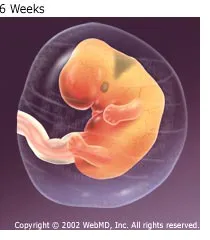Week 5
Baby: Your embryo still hasn't grown much. It's about 0.05 inches long. Heart, brain, spinal cord, muscle and bones are beginning to develop. The placenta, which will nourish your baby, and the amniotic sac, which provides a warm and safe environment where the baby can move easily, are still forming, too.
Mom-to-be: Still no big changes to notice in yourself, although you might suspect by now that you're pregnant. Some early pregnancy symptoms include nausea (called "morning sickness," although it can happen at any time of day), a tingling or soreness in your breasts and darkening of the areola, the need to urinate more frequently and feeling more tired than usual.
Tip for the Week: You'll want to schedule a visit to your OB-Gyn as soon as you suspect you're pregnant. Good prenatal care is one of the best assurances of a healthy pregnancy and healthy baby.
Week 6
Baby: The embryo is starting to look like a tadpole. It's about 0.08 inches to 0.16 inches -- the size of a BB pellet -- from the top of the head to buttocks. (This crown-to-rump length is used more often than crown-to-heel length because the baby's legs are most often bent and hard to measure). The eyes and limb buds also are forming. A heartbeat can sometimes be detected by an ultrasound around now. This is also an extremely important time in the development of your baby, since between 17 and 56 days the embryo is most susceptible to factors that can interfere with its normal growth.
Mom-to-be: You may have gained a few pounds by now, but if you're experiencing morning sickness you may have lost weight, which is also normal. You're starting to notice some changes in your body: clothes getting a little tighter around the waist, weight gain in your legs and breasts. With a pelvic exam, your practitioner will be able to notice a change in the size of your uterus.
Tip for the Week: Make sure you're following good prenatal habits, like eating right and taking your prenatal vitamins. Since the neural tube (which is the beginning of the central nervous system) has formed by now, taking folic acid to prevent spinal cord defects such as spina bifida, has been crucial. If you haven't already, stop smoking and drinking.
Week 7
Baby: Your embryo makes great strides in size this week, growing to between 0.44 inches and 0.52 inches from crown to rump by the end of the week, or about the size of a small raspberry. Leg buds are starting to look like short fins, and hands and feet have a digital plate where fingers and toes will develop. The heart and lungs are becoming more developed, as are the eyes and nostrils, intestines and appendix. By now the brain and spinal cord are growing from the neural tube.
Mom-to-be: You're still not "showing," but by now you're really feeling the changes in your body. You still may be experiencing morning sickness and the other symptoms of early pregnancy. Breasts will probably be tingly and tender.
Tip for the Week: To settle a queasy stomach, never let your stomach get empty. Keep snacks on hand around the clock, and eat lots of little meals rather than three big ones. To prevent a drop in blood sugar, include some protein like adding some cheese on crackers.
Week 8
Baby: Your embryo, now about in its sixth week of development, is about the size of a grape -- 0.56 to 0.8 inches from crown to rump. Eyelid folds and ears are forming and even the tip of the nose is visible. The arms have grown longer and bend at the elbows. Places where fingers and toes eventually will grow are becoming notched.
Mom-to-be: Your uterus, once the size of your fist, is now about the size of a grapefruit. You may feel some cramping or pain in your lower abdomen or sides, but that's because your uterus typically tightens or contracts throughout pregnancy. Consult your doctor if contractions are accompanied by vaginal bleeding.
Tip for the Week: Good breast support during pregnancy will help you feel more comfortable and prevent future sagging. Exercises to keep your chest muscles toned can be useful, too.
What's Happening Inside You?
Your baby's facial features continue to develop. Each ear begins as a little fold of skin at the side of the head. Tiny buds that eventually grow into arms and legs are forming. Fingers, toes and eyes are also forming.

The neural tube (brain, spinal cord and other neural tissue of the central nervous system) is well formed. The digestive tract and sensory organs begin to develop. Bone starts to replace cartilage.
By the end of the second month, your baby, now a fetus, is about 1 inch long, weighs about 1/3 ounce, and is virtually all head (1/3 of its body is head).
No comments:
Post a Comment